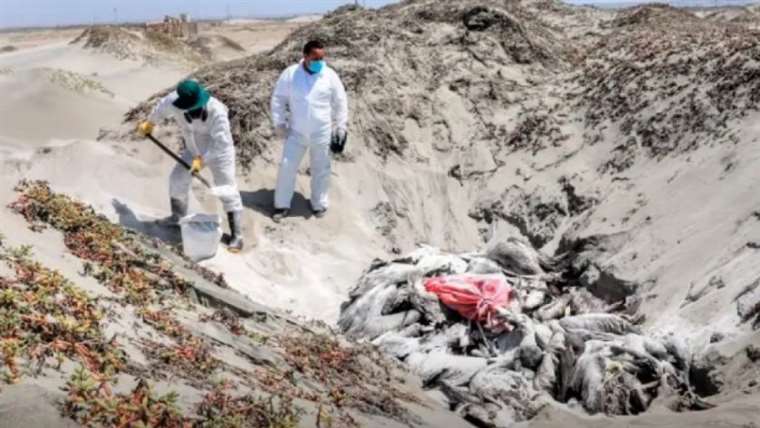December 2, 2022, 21:20 PM
December 2, 2022, 21:20 PM
Marine and coastal birds of Peru, Ecuador and Venezuela are endangered by an outbreak of avian influenza that forced to declare a health alert for at least three months to mitigate the impact caused by bird migration from the northern hemisphere.
Peru stands out so far as one of the most affected coastal countries in the region, where it is not ruled out that avian flu infections spread to other countries.
Some 17,500 seabirds, mostly juvenile pelicans, have died in the past week in the country, according to authorities.
In addition, the death on the Peruvian coast of more than 3,000 cormorants and boobies, among other species, was confirmed.
The outbreak also affects poultry, of which Some 37,000 chickens and hens have already been slaughtered. In addition, cockfighting and poultry fairs scheduled for Christmas were prohibited.
In Lima, the Peruvian capital that faces the Pacific Ocean at the foot of the cliffs that border it, surreal scenes were reported as pelicans wandering dying through the streets.
Venezuela declared a 90-day health alert on Friday in five coastal states in the north and northeast of the country, facing the Caribbean Sea.
Gabriela Jiménez, Venezuelan Minister of Science and Technology, reported on “the detection of the AH5N1 Avian Influenza virus in pelicans” in the state of Anzoátegui, in the town of Puerto Píritu (northeast).
This is the “first report of influenza type A, subtype H5, which caused the state of alert” that covers the states of Anzoátegui, Miranda, Nueva Esparta, La Guaira and Sucre, where a period of “quarantine” and epidemiological surveillance will be implemented. .
Birds that are positive or have epidemiological risk links will also be slaughtered and “gallistic events, fairs and exhibitions with the presence of birds and pigs” were prohibited.
Eyes on the Galapagos
Ecuador, which declared a 90-day animal health emergency on Wednesday due to the avian influenza outbreak, announced a plan to protect the wild birds of the Galapagos Islandswhich are home to unique flora and fauna in the world, located 1,000 kilometers from the continent, due to the outbreak of avian influenza.
“Permanent monitoring has been arranged in the areas with the greatest influx of seabirds, some of them migratory, including all visiting sites” for tourists, the Ecuadorian authorities reported.
The Galapagos, declared a Natural World Heritage Site by Unesco, are home to a diversity of wild birds, some endemic, such as penguins, finches, albatross, cormorants and hawks. These islands, named after the gigantic tortoises that live there, have 35 poultry farms that are being monitored.
The first case of avian influenza in Ecuador was detected a week ago in the province of Cotopaxi (central Andean region), which led to the declaration of an emergency.
To contain the disease, the authorities ordered the slaughter of some 180,000 birds from the affected farms and prohibited the movement of birds, products and by-products of avian origin on the farms affected by the outbreak.
What causes the outbreak?
“I don’t really know the origin of the outbreaks, but there is no evidence that it is in the Franklin gull,” ornithologist Enrique Ortiz of the NGO Andes Amazon Fund, based in Washington, United States, told AFP.
Among the birds that migrate from the northern hemisphere are the Franklin’s gull, sandpipers, plovers and coastal species that come from Alaska or the central United States, according to Ortiz.
“It’s a serious thing, we don’t know how far it will go,” he warned. But the head of Peru’s National Agrarian Health Service (Senasa), Miguel Quevedo, told AFP that “we know that it is a species that is traveling close to the coast and that is why we suspect that it is the Franklin gull“, which it usually does.
“It is a complicated situation,” he added, and said that “it is confirmed (that the migratory birds come from the north) because in the genomic sequencing studies we have been able to determine that the virus is very similar to another found in Mexico.”
The flu virulently attacks juvenile pelicans whose immune systems are weak, but deaths can also be related to a lack of food, Ortiz said.
Bird flu causes weakness in birds that prevents them from eating and they die of starvation.
“It’s a serious thing, we don’t know how far it will go,” warned Ortiz.

















